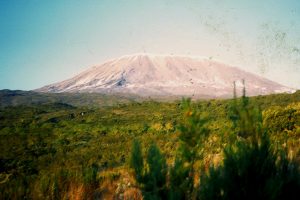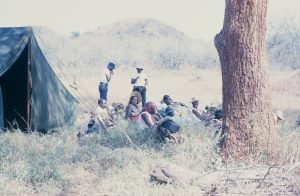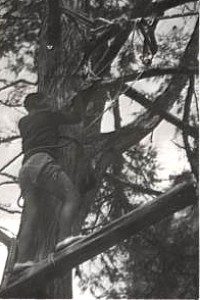- Mountain Women: Outward Bound Kenya
- Basic Training
- On the Mountain
- To the Plains
- Climbing Kilimanjaro
- Wrapping Up
Basic Training

Fifteen hours out of Mwanza, the rattling bus made its final turn into Arusha, Tanzania, and a solitary snow-capped peak swung into view. My heart flipped. I was on my way to join the Outward Bound Mountain School (OBMS) and to climb the legendary Mt. Kilimanjaro that loomed enormous in the sky as we approached.
I’d been intrigued by this equatorial volcanic peak that dared flaunt a glacier ever since reading “The Snows of Kilimanjaro” years before. Hemingway’s short story told of a leopard preserved in the ice, a mystery I long wanted to explore. By assisting in the OBMS program for girls, I would view East Africa from a place reached only by a privileged few.
The next morning, I joined an effervescent group of young women to board the bus for Loitokitok, on the southern Kenya border. Every student had been chosen by her school as a potential leader. Many knew each other, and they were wild with excitement. Would I be working with any of them? Could I do it? For six weeks, I had gone on runs with my athletics team that included the two students who would join me from Bwiru Girls’ Secondary School. Was it enough?
Outward Bound was founded by the British during World War II, when German submarines were sinking an appalling number of British ships. The British had learned that older, experienced men survived the days and sometimes weeks in the small life rafts better than the younger ones, who often gave up hope of rescue and died. When the school challenged young sailors with problem solving and survival simulations, more students proved better able to cope with sinking, which many were destined to face. After the war, the successful program added leadership training and reinvented itself as a program for civilians.
On our bumpy ride around the mountain we passed bright green coffee plantations high on the slopes. Close to the road, villagers tended clusters of banana plants. Some dwellings were round with grass roofs, while others, constructed of more modern cement bricks, were topped by metal.
At Loitokitok, a wide spot in the road, the bus turned uphill. I was taken aback by the school’s sturdy buildings and tidy grounds with pleasant flower beds. Before independence, it had served as a resort for the East African settlers, and was commandeered by the new Tanzanian government after the British left.
I was the first of the temporary instructors to arrive. We were recruited to fill in for the regular male instructors, most of whom were attending a sea course at the coast. I believed it was designed to get the men out of camp. Mixing men of authority with compliant secondary school girls could be a problem. With women in direct contact with the budding female leaders, the students would be free to fully participate without harassment.
This was my first exposure to leadership training. I had been a summer camp counselor and a student advisor in college, but I had never been trained to lead. I had lot to learn.
As I approached the dining hall for lunch, a small, trim African with a neat mustache approached me. His well-pressed khaki clothing and his excellent posture reminded me of a military man. John introduced himself as the camp director, welcomed me without a smile and told me to meet him after lunch. As he strode away, his abrupt no-nonsense manner made me wonder how much guidance I would receive for my temporary role as an instructor. This was my first exposure to leadership training. While I had been a summer camp counselor and a student advisor in college, I had never been trained to lead. I had a lot to learn.
John found me after we’d all eaten, and without explanation told me to follow him. Not far from the buildings we entered a grove of tall evergreens with a giant playground: logs, old tires, ropes, cables and nets strung in the shade. What fun! I thought.
“This is our ropes course,” John said. “We use this to build confidence in the students. Each challenge is designed to look difficult, but they are easier than they seem and eventually most of the participants succeed. You will be demonstrating this tomorrow morning. I will explain how they all work and leave you to try them out.”
“O.K.,” I said, suddenly alert.
I studied the rope bridges and ladders, balance beams, Tarzan-like swings, high pulley slides, and slack balance ropes. Several shallow pools of water lay underneath, just deep enough to add an element of humiliation to falling.
“You will not be able to practice the zip line today because I have to show you how to put on the safety gear, and I don’t have the time for that right now,” John said.
He pointed up. About thirty feet in the air was a skinny horizontal pole tied between two trees; above it, a thin cord drooped about four feet. A few feet higher ran a taut cable between the trunks. From the right-hand tree, another cable sloped down to pass through a thick cargo net suspended at the bottom. The zip line looked terrific, if a person could manage to traverse the pole to grab the pulley handle and leap into space to slide down into the net.
John left. So I practiced, and in a half hour, finished what I could of the course. My only problem was with a balance log resembling a giant teeter totter. When I gingerly stepped onto it and up the steep side to the mid-point, the log began to sway. It wasn’t like a small plank on a playground; the heavy weight changed the dynamics. At the balance point, I slowed and gradually shifted my weight, struggling to swing the log gracefully to the other side, fearing a hard hit would throw me off into a pool of water. I made it but was irritated, because falling off such a simple challenge would be disgraceful.
Back at the main campus, I found Neila Helmholtz, my friend and fellow Peace Corps volunteer, with George Brose, also in our PCV group. George had recently joined the permanent OBMS staff. I looked forward to spending a little time with them both, since I hadn’t seen them for several months.
Neila and I settled into our small room with twin beds and a bathroom and then joined the other temps for our meeting with John. We were mostly white teachers from East African secondary schools. John arrived and wasted no time telling us that he would instruct us on what to do and we would then tell the students. When we split up for expeditions, he would lead half the camp, and George would follow a day or two later with the other half. We were instructed in the evening’s task and dismissed. I left the meeting, heading spinning with excitement and anticipation.
After dinner, we met the students. There were about eighty altogether from secondary schools in Kenya, Tanzania or Uganda. Six or eight were white, twenty were Asians and the rest were Africans. Patrols were formed of about ten diverse students. I introduced myself to my patrol and after brief introductions, gave them their first challenge, which was to find a name for their group. My job was to observe which students were talking, who stayed silent, and who could influence others. They named themselves “Faru,” rhinoceros after a spirited discussion. I was busy trying to remember names and neglected to take any notes on their interactions, something I regretted when I evaluated them at the end of the course.
After all the naming was complete, John gave a clipped and emotionless overview of the next three weeks. Teamwork was paramount, he stressed, and leadership a close second. The needs of the patrol members would come before the leaders’ needs. Each day, the patrols were to choose among themselves a different captain and quartermaster so that each student would experience both positions of responsibility.
I was disappointed that John seemed so distant. Maybe it was his military background, or maybe he wasn’t used to dealing with women. Do this. The end. Where was that enthusiastic leader who could whip the group into an eager frenzy for action? George said later that the chief instructor was at the coast, which added to John’s enigma.
At 6:30 a.m. a scratchy recording of a bugle playing reveille filled the camp. Neila and I, dressed in swimsuits and tennies, stood in the chilly air, teeth chattering, as the instructors and students gathered. At last, but not soon enough for me, we sped into the forest for our first run. Just as that lovely warm feeling flooded me, we broke into a clearing and stood on the lip of an old swimming pool. The site had been carved out of the trees, and I doubted much sun ever reached it. A pipe hung over one end of the pool, spouting fresh water directly from the slopes of Mt. Kilimanjaro.
John stood at the end of the pool, fully dressed. “Jump in!” he called, urging us to swim to the other side. The only exception was for students who could not swim.
I sucked in the morning air and jumped. A tumult of gasps and splashing of ice cold water assaulted me on the surface, including my own contributions. We swam for speed, not grace, and vaulted out the other side. Our shoes dripped and squished as we raced back to our rooms.
The students have to do the run every day. We take turns being Duty Instructor, and that person is the only instructor that has to do the morning run with the girls. Toweling off from my warm shower, I calculated that I’d have to lead at least two morning runs. Mind over matter and all. These British and their stiff upper lips. Grumbling through aching teeth I uttered every stereotype and cliché I could recall that would fit and some that wouldn’t. Neila stepped out of the shower and overheard my monologue. She lightly offered to do my morning run duty because she enjoyed it.
“Alright!” I said. Whatever she wanted in return was worth it.
After breakfast, while the students tidied up the camp, we instructors had another meeting with John. He let us know he would only be interacting with the students when his expertise was needed. He would meet with us periodically to give us instructions. I was thankful, because that was enough contact with him for me. I was beginning to dislike the man. From then on, he just told us “Do this.” and we did. No elaboration.

After a military-style inspection, we gathered on the open lawn, the mountain and evergreen forest on one side and the plains below us to the north. In the increasing heat, John read quotes from famous leaders, followed by announcements. From his delivery, it sounded like a rote presentation. His heart was not in it. He briefed us on the schedule for the day, where each patrol would be during the eight course periods. My patrol was assigned to the ropes course with half the camp for the morning.
That was me, I realized.
John led the four patrols into the grove of trees and the welcome shade. I caught a glimpse of the white peak and caught my breath. Kilimanjaro! There it stood.
But first we had to prepare.
“This is our ropes course. It is your first challenge. By the end of the course, you all should be able to successfully complete this circuit. Remember that your patrol comes first, so encourage your patrol members as they meet the challenges.”
He turned to me.
“Ms. Denison will demonstrate how it is done.”
Fueled by adrenaline and in denial that anything could go wrong, I made it through the balance beam, the teeter totter log and a few other obstacles, pools of water glinting below.
Then I stood at the base of the hefty tree trunk and looked up at the zip line, wondering how it was done. The forty students gathered around.
John grabbed a six-foot piece of rope and held up a metal oval and a dangling snap link. “This is a carabiner,” he said. “You’ll use these in the ropes course and later when we get to the rocks.”
He showed me how to secure the rope around my waist, and with the rope end in my hand, carabiner dangling down, I stood ready. Facing the eager young women, he said, “Now, this is your safety. As you move through this challenge, this carabiner,” he grabbed the metal oval, “must always be connected to a safety cable so if you fall, it will only be a short distance.”
Falling a short distance wouldn’t be bad, I thought, but hanging by a rope around my waist would certainly smart.

He signaled me to climb up a makeshift ladder: two metal cables spliced with narrow wooden steps, fastened tightly to the tree. I reached up as high as I could to snap the safety carabiner onto the cable, climbed above that point and reclipped it higher up. It seemed simple, except the steps abutted the tree so I had trouble working my foot in far enough to feel really secure. I could only put my weight on my toes, which did not make me feel at all secure. Maybe the steps were deliberately fashioned as such. They looked simple, felt hard, but were really easy, as John had said.
I clutched each rung and went up, not too distressed because I had climbed trees as a kid, though not usually with an audience. When my feet reached the horizontal pole at the top, John called up to hold tight and move the ‘biner to the high cable stretched between the trees. Done. I hugged the grooved bark and managed to step around the trunk and onto the pole.
He shouted up from below: the cable was only for safety, not for my use, but I could hang onto the little bitty string that hung loosely at shoulder height. With my back securely against that wonderfully solid trunk, I grabbed the string, and realized its help was only psychological. I looked down into forty pairs of trusting eyes. Adrenaline rushed through my veins. I sucked in a deep breath, stepped out and somehow had that other tree in my arms in a flash. What luck. I was almost done.
The next part looked easy.
Foolish me.
I was to sidle around that tree, stand on the pole that extended another four feet past the trunk, reach up and back, unsnap the ‘biner, and snap it onto the zip line, the cable above me that plunged to the ground at a thirty degree angle. It was a slide, after all, not a free fall. A cord was slung between my tree and a pulley, with a handle, which was at the bottom of the zip line. My back to the tree, I pulled the cord to bring up the pulley. It stopped just out of my reach. Three inches more! The handle dangled, teasing me. All I had to do was to let go of the tree, grab the handle and zip off.
I needed more hands. One, preferably two, for the tree, one for the handle and one to hold the cord lest the pulley zip back down without me.
So I understood what I was supposed to do. Tree. Handle. Zip. The problem was I couldn’t grab the pulley handle and hold onto the tree at the same time. They were just a little too far apart. What a diabolical design. I had to let go, take a step and grab. All those eyes watching. Actually, I’d forgotten about the eyes. My attention was on remembering to breathe and reminding myself that the line was designed to look difficult, but was really easy.
After a millennium, I stepped free of the tree, grabbed the pulley handle with both hands and wow! Wind in my face, I remembered to tuck my knees up to the side to prevent rupturing my spleen when I struck the net, and I hit it in good form. The ride was way too short, but I didn’t ask for a rerun.
The students coached and cheered each other through the course with great enthusiasm, the most for the ones who had trouble. I proudly thought my patrol would do well as a team.
On the second day, they stepped up and down chairs for a cardio test, and I took their pulses at intervals and helped with the record keeping. Chris Field, the nurse, who also taught the first aid course and feminine hygiene, ran the tests. The girls got some protocol on personal cleanliness, how to poop in the bush and how to take care of menstrual issues for those not accustomed to living outside. I was glad they were paying attention to bathroom issues since the school used the same routes for all its expeditions. I wasn’t eager to find left-behinds from other groups.
In the days that followed, John briefed us temps twice a day, in his flat, bored voice. Maybe he needed a new job. We passed the instructions on to the students. They strengthened their bodies with runs, volleyball games, and fitness exercises at 6,000 feet, and took classes on knot-tying, map reading, first aid, rescue procedures and leadership skills. The non-swimmers got a short course in drown-proofing. About the time we fell into a daily rhythm, it all changed.
To the Top or go to On the Mountain